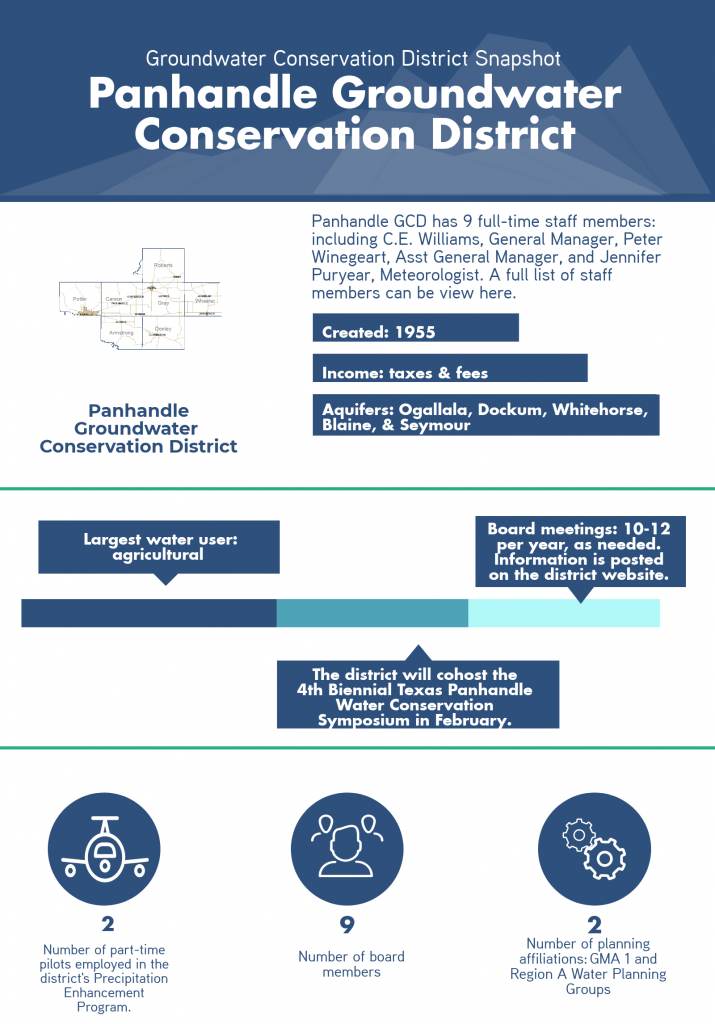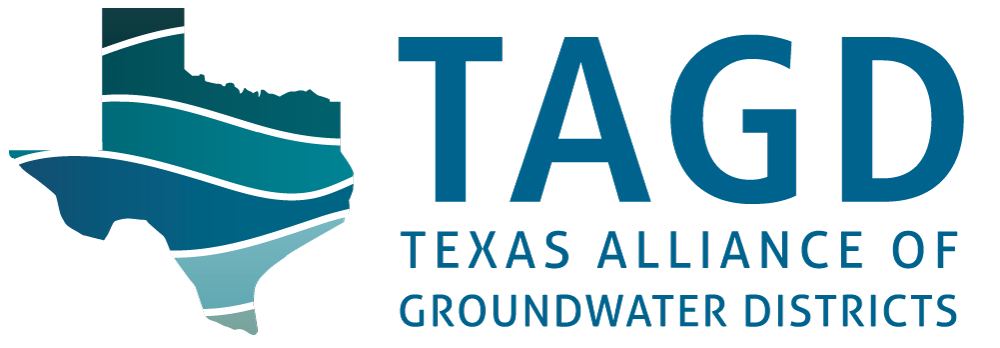Panhandle GCD

GCD Programs
Texas Panhandle Water Conservation Symposium
In February, Panhandle Groundwater Conservation District (PGCD), together with the City of Amarillo, will host its 4th Biennial Texas Panhandle Water Conservation Symposium. The symposium was conceived in 2011. As fires and drought swept across the state, PGCD saw the need to expand their education and awareness efforts around water conservation. As this fourth symposium is about to take place, the Texas Panhandle once again finds itself in the middle of a severe drought, the current streak of days with no measurable precipitation is currently at 104 days and no moisture in the seven day forecast. The previous record was 76 days set during the drought of 1957. Read more about the current drought in the Texas Tribune here.
The symposium averages 350 attendees, with those attendees spread evenly across agricultural and municipal industries, and members of the general public. With such a diverse audience, the event covers a wide variety of topics. This year’s presentations range from drones in agriculture, to cyber security and water, to water recycling and reuse. Tying it all together is the focus of the symposium: educating water users on how to conserve water efficiently and effectively.
Precipitation Enhancement Program
The district has a somewhat unique program amongst Groundwater Conservation Districts (GCDs)—with their Precipitation Enhancement Program. This program is a piece of the portfolio of water conservation programs at the  district. It’s currently in its eighteenth year of operation. Precipitation enhancement is a program to stimulate clouds to generate more rainfall than they would otherwise through the introduction of seeding agents, such as silver iodide. PGCD’s precipitation enhancement program produces on average an additional 5-10% more rainfall. The district measures additional precipitation through a independent consultant at Texas Tech University who takes radar data and compares clouds the district seeds versus those clouds that have not been seeded in the area on the same day.
district. It’s currently in its eighteenth year of operation. Precipitation enhancement is a program to stimulate clouds to generate more rainfall than they would otherwise through the introduction of seeding agents, such as silver iodide. PGCD’s precipitation enhancement program produces on average an additional 5-10% more rainfall. The district measures additional precipitation through a independent consultant at Texas Tech University who takes radar data and compares clouds the district seeds versus those clouds that have not been seeded in the area on the same day.
GCD Operations
Data Management
 At the center of all GCD operations is robust, accurate, and accessible data. PGCD uses a platform called MeterMaid, designed by Intera, to manage and access the data for the district. Using the MeterMaid program, data can be viewed in real time by office staff and can be downloaded and synced with an in-house database.
At the center of all GCD operations is robust, accurate, and accessible data. PGCD uses a platform called MeterMaid, designed by Intera, to manage and access the data for the district. Using the MeterMaid program, data can be viewed in real time by office staff and can be downloaded and synced with an in-house database.
Groundwater software and database solutions can be big commitments for a district. PGCD’s board approved the investment in the MeterMaid platform not only to improve district operational efficiency, but also to provide more accurate data. PGCD prioritizes data quality control by working to lower the risk of input errors. Two ways they do this is by additional staff reviews, and by adding a picture of a physical meter reading with a time and date stamp in the database. The MeterMaid platform has assisted the PGCD in streamlining district operations, and it also acts as an additional resource in court cases.
50/50 Management Goal
After the drought of 1997, PGCD decided to make conservation a goal of the district. The district was challenged by  their board to state what exactly that conservation goal would be. So, in 1998 the 50/50 management goal was born. The goal was to conserve water so that at least 50 percent of the aquifer remained in 50 years. In order to achieve this goal, the district reached out to producers through a series of public meetings, showing attendees hydrographs and laying out the situation if a business as usual approach was taken. This proved to be an effective method of convincing water users of the need to conserve the resource. This management goal proved to be the forerunner of the Desired Future Condition (DFC) for PGCD. Today, the DFC is an important planning tool use by GCDs in their management of groundwater.
their board to state what exactly that conservation goal would be. So, in 1998 the 50/50 management goal was born. The goal was to conserve water so that at least 50 percent of the aquifer remained in 50 years. In order to achieve this goal, the district reached out to producers through a series of public meetings, showing attendees hydrographs and laying out the situation if a business as usual approach was taken. This proved to be an effective method of convincing water users of the need to conserve the resource. This management goal proved to be the forerunner of the Desired Future Condition (DFC) for PGCD. Today, the DFC is an important planning tool use by GCDs in their management of groundwater.
Helpful Resources
Visit the Panhandle Groundwater Conservation District’s website at pgcd.us.
